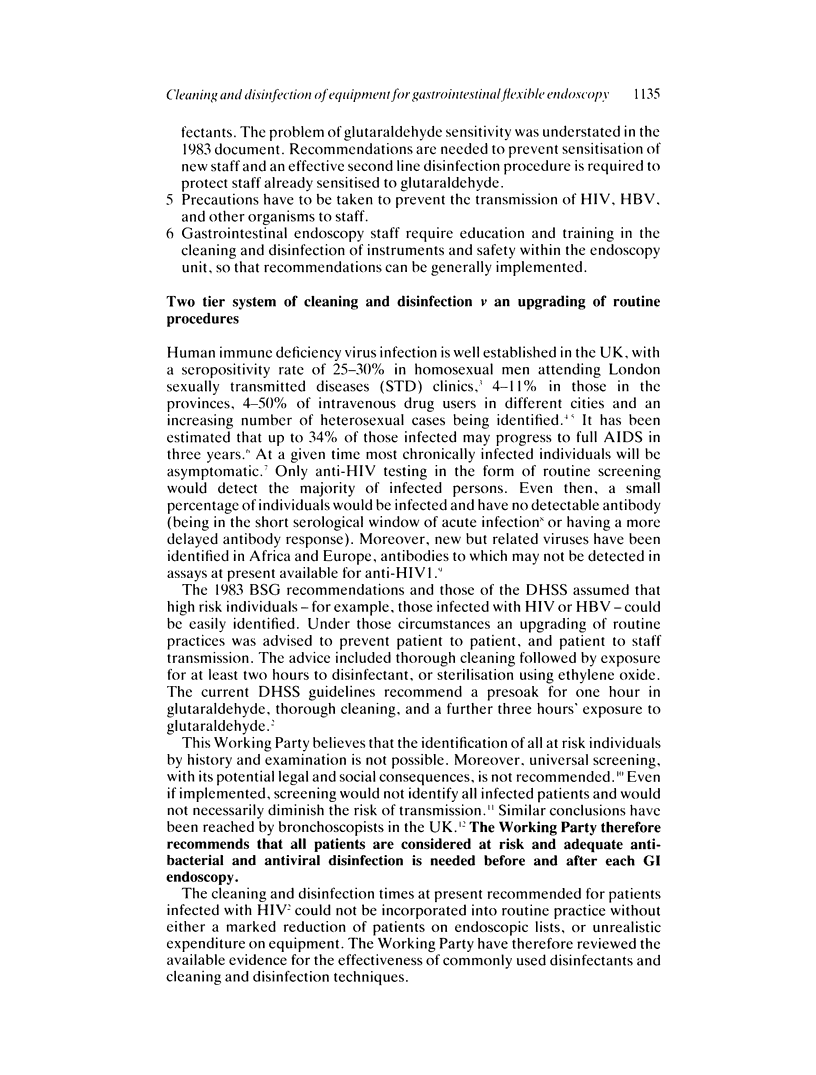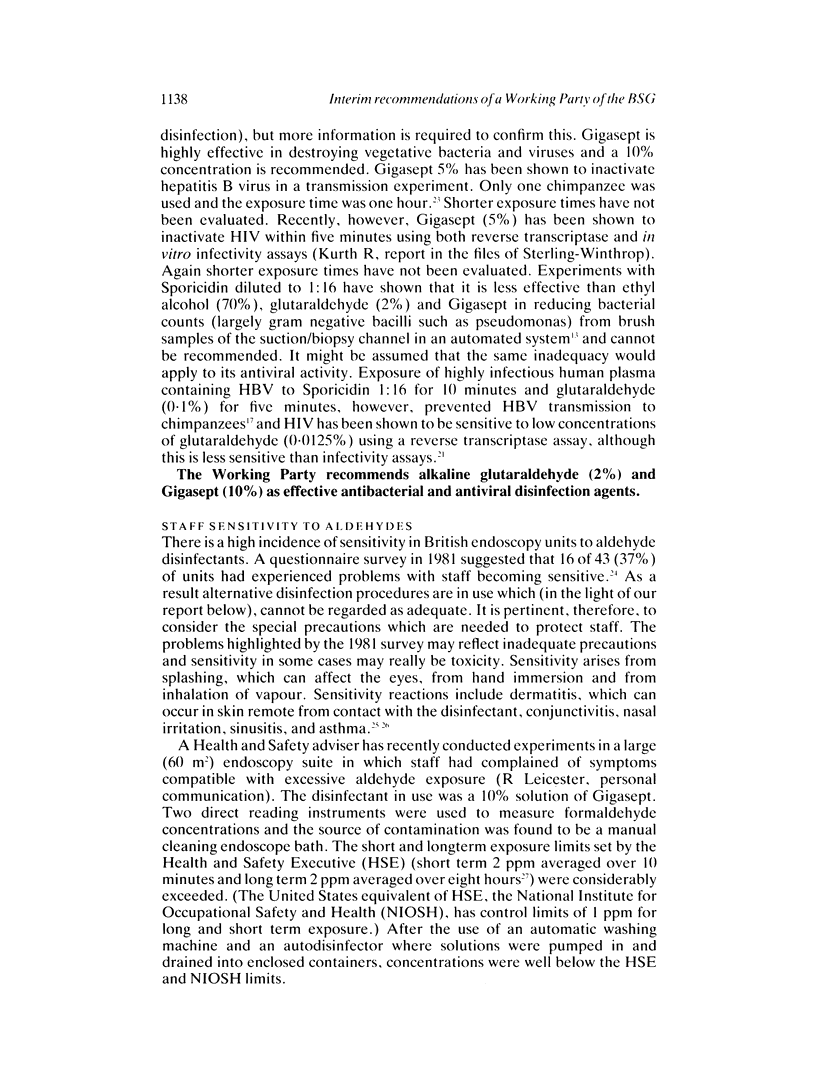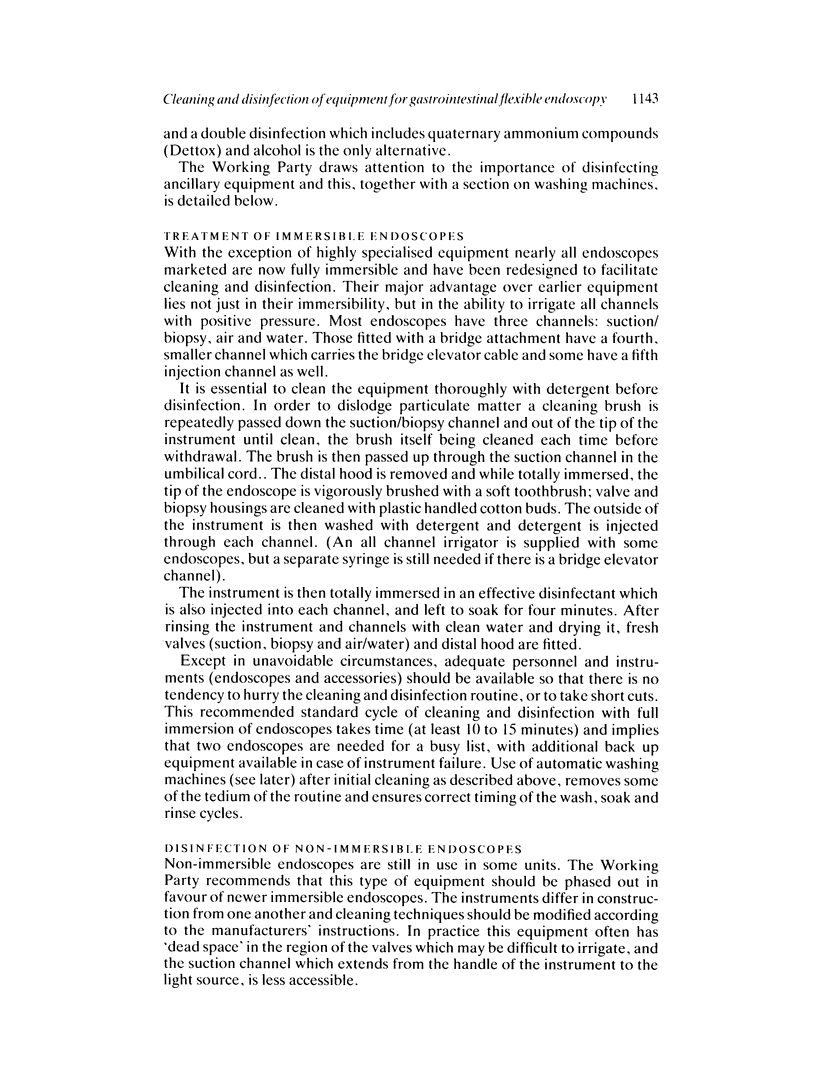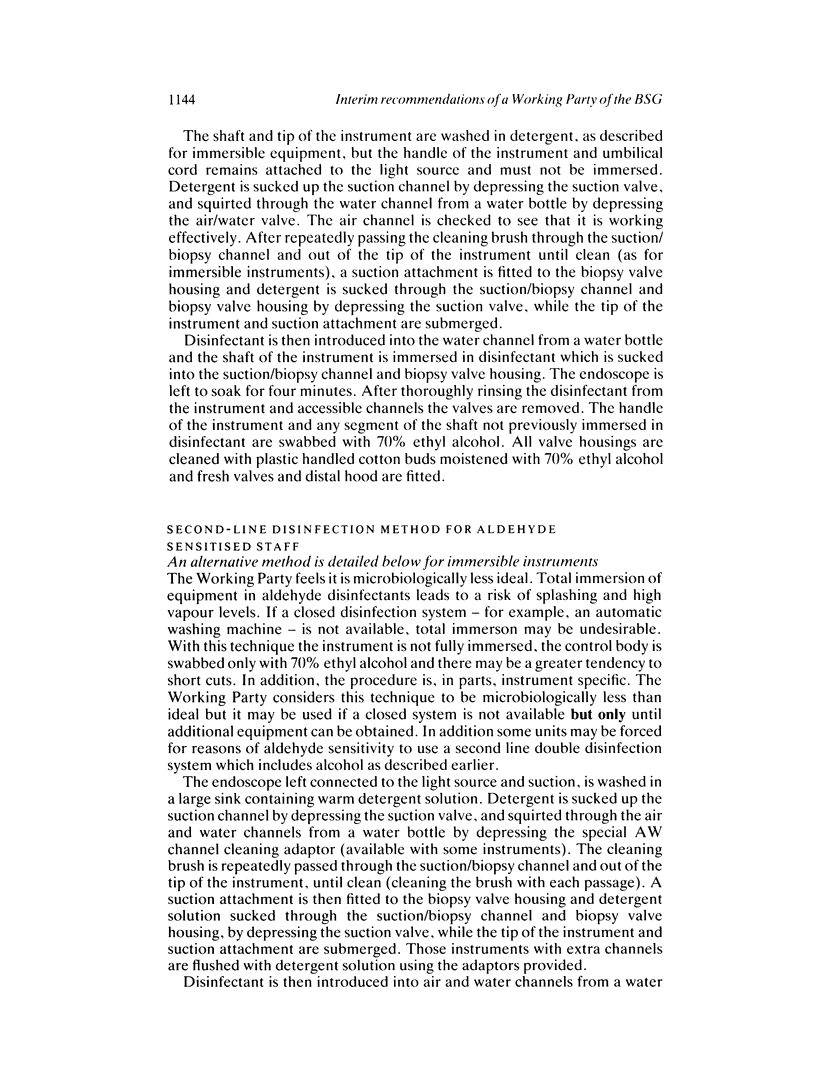Abstract
1. All patients undergoing gastrointestinal endoscopy must be considered 'at risk' for HIV and appropriate cleaning/disinfection measures taken for endoscopes and accessories. 2. Thorough manual cleaning with detergent, of the instrument and its channels is the most important part of the cleaning/disinfection procedure. Without this, blood, mucus and organic material will prevent adequate penetration of disinfectant for inactivation of bacteria and viruses. 3. Aldehyde preparations (2% activated glutaraldehyde and related products) are the recommended first line antibacterial and antiviral disinfectant. A four minute soak is recommended as sufficient for inactivation of vegetative bacteria and viruses (including HIV and HBV). 4. Quaternary ammonium detergents (8% Dettox for two minutes for bacterial disinfection), followed by exposure of the endoscope shaft and channels to ethyl alcohol (70% for four minutes for viral inactivation), is an acceptable second-line disinfectant routine where staff sensitisation prevents the use of an aldehyde disinfectant. 5. Accessories, including mouthguards and cleaning brushes, require similarly careful cleaning/disinfection, before and after each use. Disposable products (especially injection needles) may be used and appropriate items can be sterilised by autoclaving and kept in sterile packs. 6. Closed circuit endoscope washing machines have advantages in maintaining standards and avoiding staff sensitisation to disinfectants. Improved ventilation including exhaust extraction facilities may be required. 7. Endoscopy staff should receive HBV vaccination, wear gloves and appropriate protective garments, cover wounds or abrasions and avoid needlestick injuries (including spiked forceps, etc). 8. Known HIV-infected or AIDS patients are managed as immunosuppressed, and require protection from atypical mycobacteria/cryptosporidia etc, by one hour aldehyde disinfection of endoscopic equipment before and after the procedure. A dedicated instrument is not required. 9. Increased funding is necessary for capital purchases of GI endoscopic equipment, including extra and immersible endoscopes with additional accessories to allow for safe practice. 10. Greater numbers of trained GI assistants are needed to ensure that cleaning/disinfection recommendations and safety precautions are followed, both during routine lists and emergency endoscopic procedures. 11. These recommendations are based on expert interpretation of current data on infectivity and disinfection; they may require future modification.
Full text
PDF

















Selected References
These references are in PubMed. This may not be the complete list of references from this article.
- Acquired immune deficiency syndrome--recommendations of the working party. J Hosp Infect. 1986 May;7(3):295–296. [PubMed] [Google Scholar]
- Axon A. T., Banks J., Cockel R., Deverill C. E., Newmann C. Disinfection in upper-digestive-tract endoscopy in Britain. Lancet. 1981 May 16;1(8229):1093–1094. doi: 10.1016/s0140-6736(81)92252-2. [DOI] [PubMed] [Google Scholar]
- Axon A. T., Phillips I., Cotton P. B., Avery S. A. Disinfection of gastrointestinal fibre endoscopes. Lancet. 1974 Apr;1(7859):656–658. doi: 10.1016/s0140-6736(74)93202-4. [DOI] [PubMed] [Google Scholar]
- Babb J. R., Bradley C. R., Deverill C. E., Ayliffe G. A., Melikian V. Recent advances in the cleaning and disinfection of fibrescopes. J Hosp Infect. 1981 Dec;2(4):329–340. doi: 10.1016/0195-6701(81)90065-7. [DOI] [PubMed] [Google Scholar]
- Birnie G. G., Quigley E. M., Clements G. B., Follet E. A., Watkinson G. Endoscopic transmission of hepatitis B virus. Gut. 1983 Feb;24(2):171–174. doi: 10.1136/gut.24.2.171. [DOI] [PMC free article] [PubMed] [Google Scholar]
- Bond W. W., Favero M. S., Petersen N. J., Ebert J. W. Inactivation of hepatitis B virus by intermediate-to-high-level disinfectant chemicals. J Clin Microbiol. 1983 Sep;18(3):535–538. doi: 10.1128/jcm.18.3.535-538.1983. [DOI] [PMC free article] [PubMed] [Google Scholar]
- Carne C. A., Weller I. V., Johnson A. M., Loveday C., Pearce F., Hawkins A., Smith A., Williams P., Tedder R. S., Adler M. W. Prevalence of antibodies to human immunodeficiency virus, gonorrhoea rates, and changed sexual behaviour in homosexual men in London. Lancet. 1987 Mar 21;1(8534):656–658. doi: 10.1016/s0140-6736(87)90415-6. [DOI] [PubMed] [Google Scholar]
- Carne C. A., Weller I. V., Loveday C., Adler M. W. From persistent generalised lymphadenopathy to AIDS: who will progress? Br Med J (Clin Res Ed) 1987 Apr 4;294(6576):868–869. doi: 10.1136/bmj.294.6576.868. [DOI] [PMC free article] [PubMed] [Google Scholar]
- Corrado O. J., Osman J., Davies R. J. Asthma and rhinitis after exposure to glutaraldehyde in endoscopy units. Hum Toxicol. 1986 Sep;5(5):325–328. doi: 10.1177/096032718600500505. [DOI] [PubMed] [Google Scholar]
- Dyer C. Testing for HIV: the medicolegal view. Br Med J (Clin Res Ed) 1987 Oct 10;295(6603):871–872. doi: 10.1136/bmj.295.6603.871. [DOI] [PMC free article] [PubMed] [Google Scholar]
- Elson C. O., Hattori K., Blackstone M. O. Polymicrobial sepsis following endoscopic retrograde cholangiopancreatography. Gastroenterology. 1975 Aug;69(2):507–510. [PubMed] [Google Scholar]
- Henderson D. K., Saah A. J., Zak B. J., Kaslow R. A., Lane H. C., Folks T., Blackwelder W. C., Schmitt J., LaCamera D. J., Masur H. Risk of nosocomial infection with human T-cell lymphotropic virus type III/lymphadenopathy-associated virus in a large cohort of intensively exposed health care workers. Ann Intern Med. 1986 May;104(5):644–647. doi: 10.7326/0003-4819-104-5-644. [DOI] [PubMed] [Google Scholar]
- Jaffe H. W., Darrow W. W., Echenberg D. F., O'Malley P. M., Getchell J. P., Kalyanaraman V. S., Byers R. H., Drennan D. P., Braff E. H., Curran J. W. The acquired immunodeficiency syndrome in a cohort of homosexual men. A six-year follow-up study. Ann Intern Med. 1985 Aug;103(2):210–214. doi: 10.7326/0003-4819-103-2-210. [DOI] [PubMed] [Google Scholar]
- Kobayashi H., Tsuzuki M., Koshimizu K., Toyama H., Yoshihara N., Shikata T., Abe K., Mizuno K., Otomo N., Oda T. Susceptibility of hepatitis B virus to disinfectants or heat. J Clin Microbiol. 1984 Aug;20(2):214–216. doi: 10.1128/jcm.20.2.214-216.1984. [DOI] [PMC free article] [PubMed] [Google Scholar]
- McCray E. Occupational risk of the acquired immunodeficiency syndrome among health care workers. N Engl J Med. 1986 Apr 24;314(17):1127–1132. doi: 10.1056/NEJM198604243141729. [DOI] [PubMed] [Google Scholar]
- McEvoy M., Porter K., Mortimer P., Simmons N., Shanson D. Prospective study of clinical, laboratory, and ancillary staff with accidental exposures to blood or body fluids from patients infected with HIV. Br Med J (Clin Res Ed) 1987 Jun 20;294(6587):1595–1597. doi: 10.1136/bmj.294.6587.1595. [DOI] [PMC free article] [PubMed] [Google Scholar]
- Moss A. R. AIDS and intravenous drug use: the real heterosexual epidemic. Br Med J (Clin Res Ed) 1987 Feb 14;294(6569):389–390. doi: 10.1136/bmj.294.6569.389. [DOI] [PMC free article] [PubMed] [Google Scholar]
- Nath N., Fang C. T., Dodd R. Y. Inactivation of DNA-polymerase associated with hepatitis B virus. J Med Virol. 1982;10(2):131–140. doi: 10.1002/jmv.1890100207. [DOI] [PubMed] [Google Scholar]
- O'Connor H. J., Axon A. T. Gastrointestinal endoscopy: infection and disinfection. Gut. 1983 Nov;24(11):1067–1077. doi: 10.1136/gut.24.11.1067. [DOI] [PMC free article] [PubMed] [Google Scholar]
- O'Connor H. J., Steele C. S., Price J., Lincoln C., Axon A. T. Disinfection of gastrointestinal fibrescopes--evaluation of the disinfectants Dettox and Gigasept. Endoscopy. 1983 Nov;15(6):350–352. doi: 10.1055/s-2007-1021553. [DOI] [PubMed] [Google Scholar]
- Parry J. V., Mortimer P. P. Place of IgM antibody testing in HIV serology. Lancet. 1986 Oct 25;2(8513):979–980. doi: 10.1016/s0140-6736(86)90632-x. [DOI] [PubMed] [Google Scholar]
- Resnick L., Veren K., Salahuddin S. Z., Tondreau S., Markham P. D. Stability and inactivation of HTLV-III/LAV under clinical and laboratory environments. JAMA. 1986 Apr 11;255(14):1887–1891. [PubMed] [Google Scholar]
- Spire B., Barré-Sinoussi F., Montagnier L., Chermann J. C. Inactivation of lymphadenopathy associated virus by chemical disinfectants. Lancet. 1984 Oct 20;2(8408):899–901. doi: 10.1016/s0140-6736(84)90657-3. [DOI] [PubMed] [Google Scholar]
- Tyler R., Ayliffe G. A. A surface test for virucidal activity of disinfectants: preliminary study with herpes virus. J Hosp Infect. 1987 Jan;9(1):22–29. doi: 10.1016/0195-6701(87)90090-9. [DOI] [PubMed] [Google Scholar]


